Friday, 1 July 2005
Distance 24 km
Duration 5 hours 10 minutes
Ascent 342 m, descent 335 m
Map 48 of the TOP100 blue series (now superseded)

I was paid back at dawn for having pinched and punched Keith in Bléré a month ago. The fact that a month had passed and we had travelled so far made us realise how our life had fallen into a pattern of steady daily progress, a sort of moral tale illustrating the virtue of perseverance.
It never occurred to us to do anything other than walk onwards every morning and we relished setting off into fresh fields, with all their unexpected delights and tribulations.
When we crawled out, everything was dewy after the rain and our washing had been soaked. Keith had to put on wet shorts and T-shirt, a feat that I was not called upon to emulate, as my clothes had dried and been collected before the downpour.
We ate our muesli on the riverbank, where there was a monumental table made of a single enormous slab of some red timber, with a shallow pool of rain water in the middle. Our host drove off to take his children to school for the last time before the summer holidays.
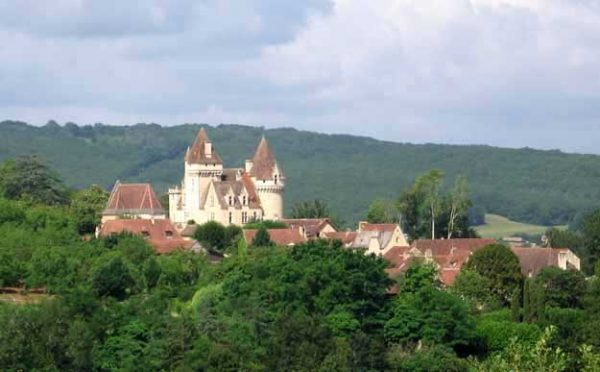
The GR came right past the camping ground and continued up the river. It was a tree-lined old road, the former main road to Beynac, judging by the little stone waymarks, but now only took local traffic.
After a while we crossed a bridge to Allas-les-Mines, which was still functioning as a mining village but had nothing to offer the passing walker.
Opposite the sober little church was a broken-windowed former café, its writing half effaced over the door. It was a sad sight and one that we expect to see more and more often in coming years, now that everybody has a car, as the big supermarkets in larger towns seduce shoppers away from their own village.

Leaving the GR to roam in the hills, we took the tiny river road. A few easy kilometres further on, the road began to twist and rise in a forest, then fall to the foot of the Château of Milandes.
Beside the road was a leisure park bearing the name of Josephine Baker, the black American vaudeville artist who lived in the Château of Milandes and raised her “rainbow tribe” of adopted children there.
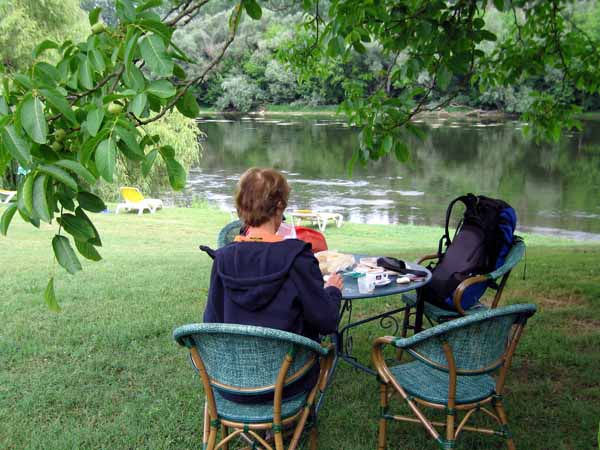
We went through the open gates in search of the promised bar, which we found in a substantial villa in the grounds.
There were workmen with ladders, gardeners attending to the beds, but no other customers. We settled down on the lawn, at a table within sight of the Dordogne, for our first coffee of the day, which was magically reviving.
Our hostess told us that the forecast was for very hot weather, good for her with her swimming pool and shady café, but bad for us.
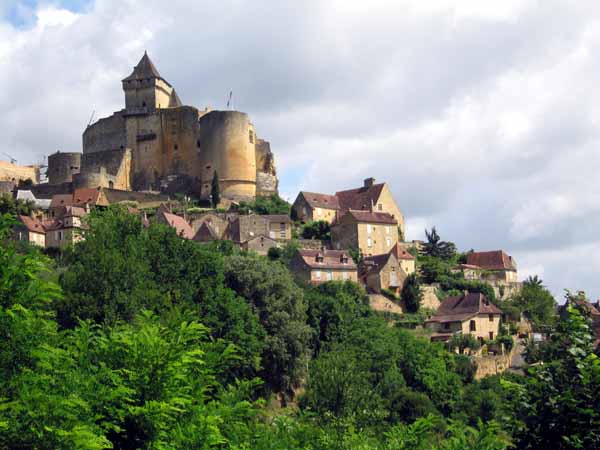
From there we took to the GR again, a stony track rising strenuously to a saddle, with views across the of the romantic spires of Josephine Baker’s château.
Down just as steeply, we came to a far more dramatic château on a bluff above the river. This was Castelnaud, a grim twelfth-century fort that was perpetually at war with the one at Beynac across the river, especially during the Hundred Years’ War.
Part of it is in ruins now, and juts out raggedly into the void. In Renaissance times the lord built the nearby Château of Milandes to please his lady, who found Castelnaud too gloomy.
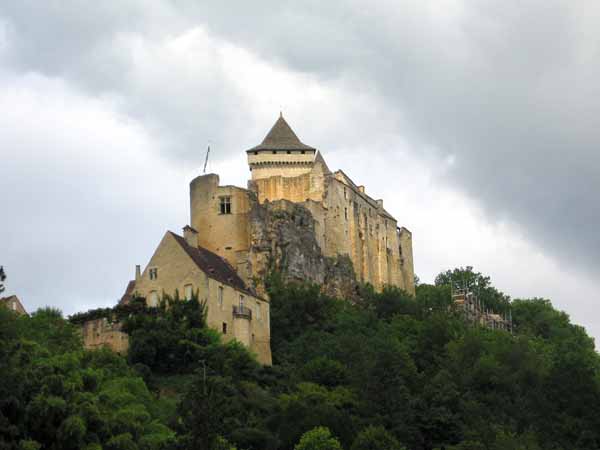
At the bridge below the castle was a small tourist village where we had a second round of coffee, pleasant but not as wonderful as the first one, since we had not walked as far to get it.
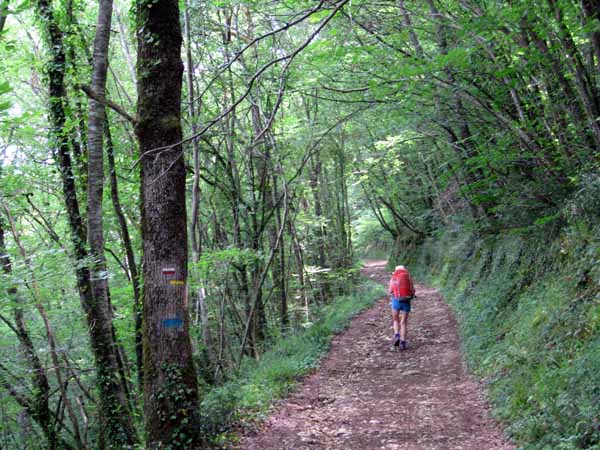
From here the GR took us on an ingenious set of paths, first up the side stream amongst fields, then across a small bridge and up into a forest high above the Dordogne, halving the road distance to Domme.
It was a classic example of what a GR can do – give the passing walker the benefit of knowledge that only local people would normally have.
After the hamlet of Saint-Julien the track tumbled down a rocky cleft and delivered us to the low road, where the land flattened out into farmland.
We had our lunch in a walnut plantation at a picnic table placed there seemingly for our convenience.
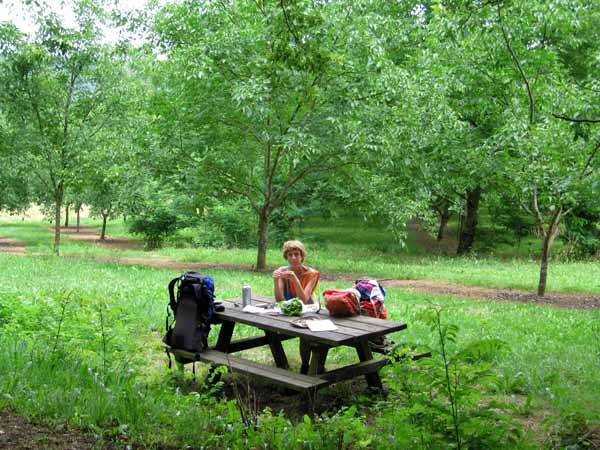
The path along the river took us past feathery green ribbons of asparagus, then maize fields with their big ungainly sprinklers pumping. Maize is grown for biofuel and is becoming more common every year.
Soon we came out onto the main road at the bridge, and the entrance of the municipal camping ground.
The sign said Cenac, not Domme, and in our ignorance we thought there might be another camping ground closer to Domme itself, which is high above. We also thought there was another road to the top, from the eastern side.
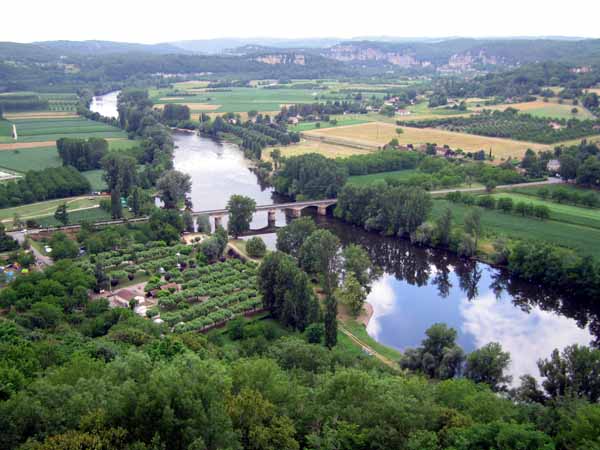
All these thoughts were wrong, as we discovered after walking for miles on a deserted river road under the promontory of Domme.
Turning back, we set ourselves up in the Cenac camping ground, as we should have done a couple of hours earlier. As so often, our tent was within a few steps of the quietly gliding river.
Domme is an awkward little town crammed onto a knob of rock, hard to get to from any direction. The road up is a tribute to modern engineering, clinging to the wooded cliff in a wide Z shape.
Halfway up was a monument to some villagers slaughtered by the retreating Germans in June 1944, the sort of monument that we have seen all over France.
Near the top we took a walking track through the ruins of Old Domme, to a little park with a view over the river flats.

The centre retains its square 13th-century bastide formation and three of the portals of the massive defensive wall are still standing. In the main square is a fine halle, and there are also grottoes in which the inhabitants sheltered from time to time in their history.
The trouble is that the place is so crawling in tourists that it is hard to appreciate its charms. The shops sell gifts, snacks, souvenirs and little else, and the shopkeepers have the glazed, slightly resentful look of those in Montmartre or the Rue Rivoli. However we did find a small food shop and bought bread for tomorrow, just in case we did not get to Sarlat in time, day-old bread being a lot better than starvation.
We had our pastis and rosé at a large bar in the lower square and ended up eating at the same place. Most of the tourists seemed to have departed, and a chill came into the air.

The heat promised by our hostess at Milandes had not transpired, but we sat close to a wall that was still warm from the day, and were quite comfortable.
It was a standard French meal, which is to say, delicious and elegantly presented salade composée to begin, then steak with eschallot sauce and a baked potato, then icecream for Keith and coffee for me.
Dusk was well advanced by the time we got back down to our little tent.
Previous day: les Eyzies to St-Cyprien